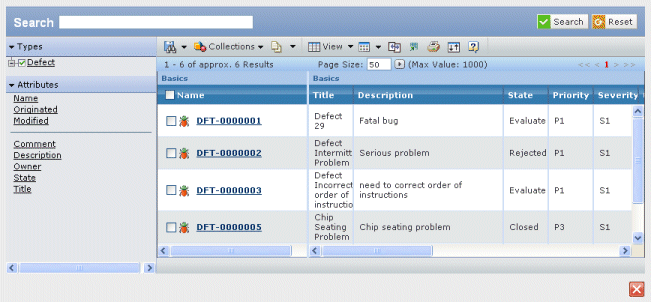From the global toolbar, click then select the type you are looking for: Defects, Defect Actions, or Implementation Reviews.

The results list shows the first page of all types.
To filter the results list based on a collection, select Collections and the name of the collection. The results list shows only those objects in the selected collection that meet the criteria.
To filter the results list based on attribute values:
Note:
The attributes listed depend on the type of object you are searching for.
- Click an Attribute name.
If the attribute contains text, a box opens where you enter the text to search for. If the attribute contains a range of values, a list box of values for that attribute pops open and you can click the needed value(s).

The numbers after the value indicate how many objects have that value. Some attributes allow you to select more than one value. Use shift-click to select a range of values; use control-click to select individual values. If the attribute contains dates (and there are many values) you can select On, On or after, On or before, or Between and enter a value. Use the calendar tool to enter date values. If there are fewer than a system-set value (the default is 10), the values show as a list.

If the attribute contains yes/no values, click the option button for Yes or No.
- Click
 . The results are filtered based on objects that have that value for that attribute. If you selected a date range, a numeric range, or multiple values for an attribute, a column for that attribute is added to the results table. . The results are filtered based on objects that have that value for that attribute. If you selected a date range, a numeric range, or multiple values for an attribute, a column for that attribute is added to the results table.
- Continue selecting values for attributes as needed to filter the results list.
The checked items at the top of the navigation list show the criteria used to generate the results list, called a breadcrumb trail.
To search for specific text that could appear in ANY attribute of an object:
-
Type the keyword or text string in the Search box at the top of the page.
Your system has a minimum required number of characters (default is 3) when using a wildcard. For example, you can enter "Pro*" in the box, but not "Pr*". Your Business Administrator may have increased or decreased this minimum. Note:
You cannot use a single wildcard character in a multiword query that has spaces between the words unless the wildcard appears at the end of the query. Use a second wildcard to balance the first wildcard. For example, the queries "the cow jumped" and "the cow jumped*" are valid and the queries "th* cow jumped" and "t*e cow jumped" are not valid.
-
Click Search.
The results section is updated to show objects that contain that text as any attribute value. The search is not case-sensitive and the results include all matches based on pieces of the given string. Non-alphanumeric characters are not recognized by the search engine.
If the searched-for text is found more than once for an object, a single row presents the found data for that object (not a separate row for each time the searched-for text is found), without indicating where the text was found.
To change the number of rows in the search results, enter an integer in the Page Size box and click the button next to it. The number after that button indicates the maximum number you can enter.
|